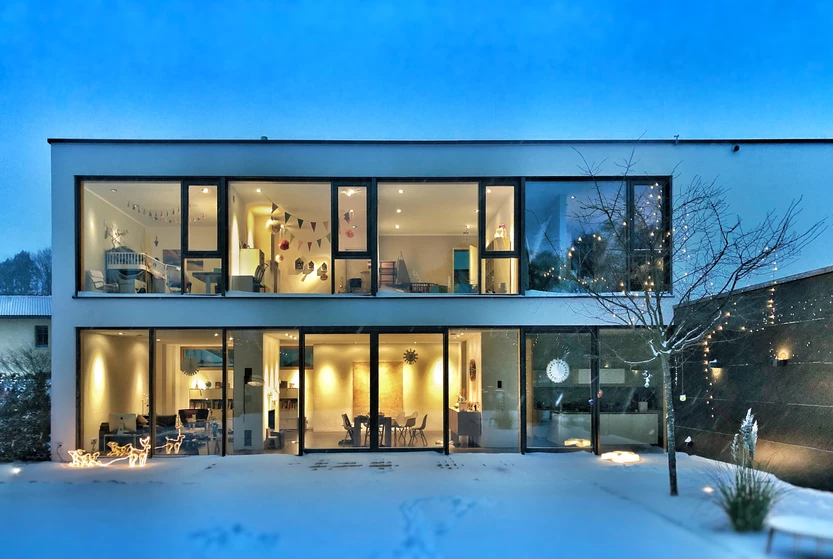How your smart home can help you limit your carbon footprint
The era when smart homes were a luxury, that very few had access to, is long gone. With each day, smart technologies are becoming more and more accessible, affordable and varied in terms of their features and customisation options. With all that rapid development of smart home solutions, manufacturers do not remain indifferent towards the ecological issues that the Earth is facing.
Smart technologies make sure that your household uses exactly as much power as it needs. Therefore, properly designed and installed solutions, while adding simplicity and convenience to your life, can not only help you lower your carbon footprint, but also your electricity and water bills.
Energy monitoring
Electricity production is the source of 25% of greenhouse gas emissions. It is a common and encouraged practice to keep all unused devices off whenever possible. In the past, the primary reason behind that was to minimise our electricity bills. However, our society has been becoming more aware of the serious effects of our energy consumption on the environment. We have far more reasons for eco-friendly behaviors now – one of them being protecting the world around us.
Installing smart home devices in your household can give you countless options, for instance, automatically limiting excessive energy use or energy monitoring. It can allow you to identify the appliances that consume the highest amounts of power, but also automatically switch off any unused devices. Home lighting automation can ensure that your lights are only switched on when necessary. Various energy monitoring units can show you different usage patterns or even specific real time data.
These systems will not only provide you with detailed information on your home’s energy use, but they also offer energy management features which can automatically make changes and adjust the activity of some of your home appliances to make your home as energy-efficient as possible.
Smart heating
Keeping our homes warm, regardless of whether our heating systems are electricity, coal or solar panel-based, significantly contributes to our carbon footprint. Of course, there are plenty of ways in which we can limit the amount of heat we use to keep our spaces heated. We can properly insulate our homes, close off unused rooms, allow sunlight inside and countless more. Smart heating systems, however, manage this process for you, making it almost thoughtless and far more efficient.
Heating automation systems offer numerous options of customisation which allows us to fulfill the specific requirements and needs of your space. They can also be integrated with other elements of your home automation system, such as automated shading, working even better to increase your energy savings and solar gains.
One of the most popular smart heating solutions, that both simplify your home life and optimise your energy consumption, are smart thermostats. They are a practical solution that can be integrated with heating and cooling systems. Those little devices offer surprisingly many practical features. They can detect the number of people in the room and adjust heating settings, or turn it off entirely if the room is empty. They are capable of remembering and analyzing people’s schedules and behavioral patterns to adjust the activity of your entire heating system. If you typically leave your home for work for 10 hours, while you’re away your smart heating system will not consume energy in vain, but it will still make sure that your home is warm upon your return.
Smart heating systems can ensure that your home uses exactly as much power as it needs to keep you comfortable.
Water
When we think of the environmental and economic benefits of having a smart home, we usually focus on electricity management and savings. There are, however, many ways in which smart home systems can help us limit our water consumption.
Approximately 6% of carbon emissions come from household water use. Smart home solutions can help us not only monitor and analyse specific information on water used in our house, but they can also efficiently limit its excessive consumption.
An example of a highly convenient solution is smart sprinklers. Lawn maintenance can be an absorbing task. Smart irrigation systems can make the process of lawn-maintenance both simple and environmentally-efficient. They come with sensors that analyse the weather and soil humidity in order to adjust water usage. That can be especially useful in summer when outside temperature is much higher. Then, it becomes more difficult for us not to under- or over-water our lawns. Smart sprinklers will use their sensors to analyse current data and know exactly how much water we need to keep our lawns in a perfect condition. As with other smart home solutions, they can be customised to be controlled from a smartphone or simply, by voice.
There are plenty of other ways in which we can excessively use water, even as simple as tap leaks. For instance, one of the most common and accessible home automation providers – Control4 – offers a special water sensor that detects leaks and reports them to you right away.
Is it worth it?
Yes! Smart home installation can provide you with customisable solutions crafted to fulfill the specific needs of your space. We can work with you to design a system that will work just right for you, making your home experience comfortable, convenient and highly energy-efficient.
There are plenty of simple and fully automated ways to limit your household’s carbon footprint. They can be integrated into a smart home system which makes them a perfectly simple and easy to control solution, helping you and your family work towards a cleaner world.
The Micarta Team are based in Kent, England. We are specialists in professional integrated technologies and provide the highest quality design, installation and service to our customers.
020 3026 9931 | info@micarta.co.uk | Kent, England, United Kingdom | Monday – Friday 0800 – 1800


